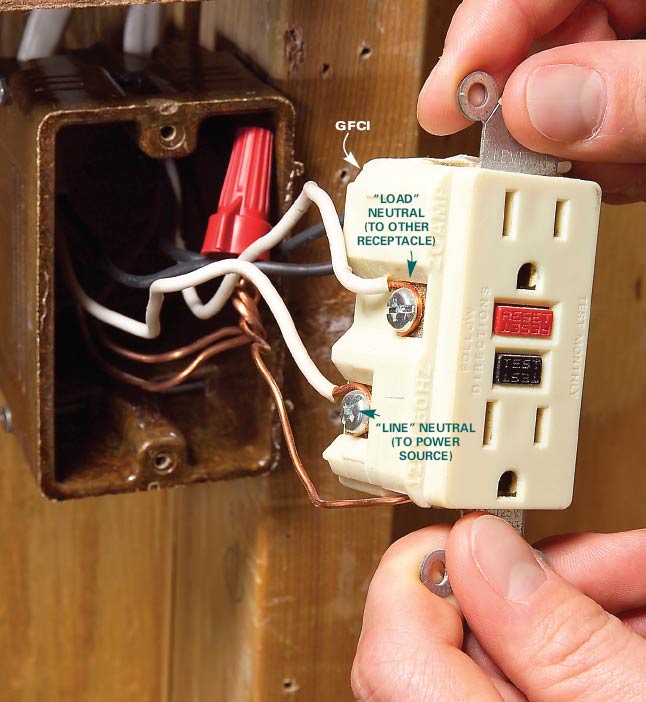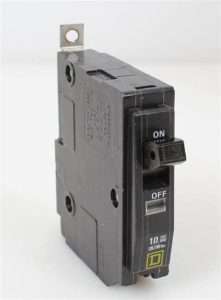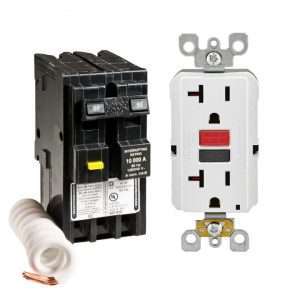Upgrading to GFCI Outlets: Enhancing Electrical Safety in Older Homes
In older homes, the electrical systems may not be equipped with the advanced safety features we have today. The Ground Fault Circuit Interrupter (GFCI) outlet is a part of electrical safety. However, outdated electrical systems in older homes often lack GFCI protection, leaving residents vulnerable to electrical shocks and potential hazards. In this blog post, we will explore the importance of upgrading GFCI outlets in older homes, their benefits, and the steps involved in the process.
Understanding the Need for Upgrading Outlet Receptacles
a. Enhanced Safety: GFCI outlets provide superior protection against ground faults, reducing the risk of electrical shocks and potential electrocution. Older homes may only have standard outlets, which lack the built-in safety mechanisms of GFCIs. Upgrading to GFCI outlets significantly improves electrical safety.
b. Code Compliance: Electrical codes have evolved over the years to prioritize safety. GFCI outlets are now required in specific locations, such as kitchens, bathrooms, garages, and outdoor areas. Upgrading to GFCIs ensures compliance with current electrical codes, reducing the risk of code violations and potential fines.
c. Protecting Modern Appliances: Older homes may not have been designed to accommodate the electrical demands of modern appliances. GFCI outlets with higher amp ratings can handle larger electrical loads, providing adequate power for appliances such as refrigerators, air conditioners, and washing machines.
2. Benefits of GFCI Outlet Upgrades
a. Ground Fault Detection: GFCI outlets continuously monitor the electrical current flow, promptly tripping the circuit if a ground fault is detected. This fast response helps prevent electrical shocks and reduces the risk of electrical fires, providing invaluable protection for you and your home.
b. Expanded Coverage: Upgrading to GFCI outlets ensures that all required locations, such as bathrooms, kitchens, and outdoor areas, are adequately protected. By providing comprehensive coverage, you create a safer environment for you and your family.
c. Retrofitting Options: Retrofitting GFCI outlets in older homes is possible even without rewiring the entire electrical system. Through the use of GFCI outlet receptacles, homeowners can replace existing outlets with GFCI outlets without extensive electrical modifications, making the upgrade more feasible and cost-effective.
3. Steps for Upgrading GFCI Outlets
a. Identify GFCI-Required Locations: Determine the areas in your home where GFCI protection is necessary. Common locations include bathrooms, kitchens, garages, outdoor outlets, and crawl spaces. Check local electrical codes for specific requirements in your area.
b. Select the Right GFCI Outlets: Choose the appropriate type of GFCI outlets based on the amp rating and design. Consider the electrical load requirements of each location to ensure the outlets can handle the demand. Consult with a licensed electrician if you need assistance in selecting the right outlets.
c. Turn off Power: Before working on any electrical outlets, ensure your safety by turning off the power at the circuit breaker. Verify that the power is completely shut off using a non-contact voltage tester.
d. Remove Existing Outlets: Carefully remove the old outlets, following proper safety precautions. Make note of the wiring connections and take pictures if necessary to aid in the installation of the new GFCI outlets.
Different Types of GFCI Outlets
1. GFCI Outlet Receptacles: These are the most common type of GFCI outlets and are designed to replace existing standard outlets. They have built-in GFCI protection and provide shock prevention. They are available in various configurations, such as standard duplex outlets, decorator outlets, and tamper-resistant outlets.
2. GFCI Circuit Breakers: These GFCIs are installed at the electrical panel and provide GFCI protection to an entire circuit. They monitor the current flowing through the circuit and trip if a ground fault is detected. GFCI circuit breakers are commonly used in situations where GFCI protection is required for all outlets on a specific circuit.
3. Portable GFCI Devices: These GFCIs are compact and portable, designed for temporary use with electrical appliances or tools. They typically have a GFCI plug that can be inserted into a standard outlet, providing protection to the device connected to it. Portable GFCI devices are commonly used in construction sites, outdoor events, or when using power tools in wet locations.
Features and considerations:
– Protection Level: All types of GFCIs offer protection against ground faults and electrical shocks, with the primary difference being the scope of protection. Outlet receptacles protect the specific outlet they are installed on, while circuit breakers offer protection to an entire circuit. Portable GFCI devices protect the connected appliance or tool.
– Installation: GFCI outlet receptacles can be installed as replacements for existing outlets, requiring basic wiring knowledge or professional installation. GFCI circuit breakers require installation at the electrical panel, which may require the expertise of a licensed electrician. Portable GFCI devices simply need to be plugged into an existing outlet.
– Flexibility: GFCI outlet receptacles provide flexibility as they can be installed in specific locations where GFCI protection is needed, such as kitchens, bathrooms, and outdoor areas. GFCI circuit breakers offer comprehensive protection for all outlets on a specific circuit. Portable GFCI devices provide flexibility for temporary or portable applications.
– Cost: The cost of GFCI outlets can vary depending on the type and brand. GFCI outlet receptacles are generally more affordable compared to GFCI circuit breakers, which may require professional installation. Portable GFCI devices are usually less expensive and offer a temporary solution.
When choosing the appropriate type of GFCI, consider the specific needs of your electrical system and the areas that require protection. It’s advisable to consult with a licensed electrician to determine the best option for your situation and ensure compliance with local electrical codes.
e. Install and Connect GFCI Outlets: Install the new GFCI outlets, following the manufacturer’s instructions. Connect the wiring correctly, ensuring that the line and load connections are properly made. Use wire connectors or screw terminals for secure connections.
f. Test and Reset: After installation, test each GFCI outlet by pressing the “Test” button to simulate a ground fault. The outlet should trip and cut off power. Reset the outlet by pressing the “Reset” button. Test all outlets in GFCI-protected locations to ensure they are functioning correctly.
Regular maintenance of GFCI outlets can prevent unnecessary tripping. This can include cleaning the outlet, checking for loose connections, and tightening terminal screws. Additionally, emphasizing the importance of periodic testing using the “Test” and “Reset” buttons can ensure the GFCI is functioning correctly.
1. Cleaning the Outlet
Regular cleaning of GFCI outlets is essential to ensure proper functionality. Over time, dust, dirt, and debris can accumulate around the outlet, potentially obstructing the electrical connections. Encourage readers to turn off the power to the outlet and use a soft, dry cloth or a small brush to gently remove any dirt or debris. Avoid using liquid cleaners or abrasive materials that could damage the outlet.
2. Checking for Loose Connections
Loose connections can lead to inefficient electrical flow and increase the likelihood of GFCI tripping. Encourage readers to periodically inspect the outlet for any loose terminal screws or wires. Using a screwdriver, they can tighten the terminal screws to ensure secure connections. However, it’s important to emphasize the need to turn off the power before attempting any repairs or maintenance.
3. Testing with “Test” and “Reset” Buttons
Regular testing of GFCI outlets is crucial to verify their functionality. Remind readers to perform a monthly test using the “Test” button on the outlet. Pressing the “Test” button should cause the GFCI to trip and cut off power. After testing, they should reset the outlet by pressing the “Reset” button. This process ensures that the GFCI is responsive and capable of detecting ground faults effectively.
4. Replacing Faulty GFCI Outlets
Despite regular maintenance, GFCI outlets can wear out or become faulty over time. If a GFCI outlet fails to trip or reset properly during testing or shows signs of physical damage, it may be necessary to replace it. Encourage readers to consult a qualified electrician for proper installation and ensure they choose a suitable replacement GFCI outlet that meets the required specifications.
5. Educating on GFCI Outlet Lifespan
While maintenance is crucial, it’s important to educate readers about the lifespan of GFCI outlets. GFCIs typically last around 10-15 years, after which they may become less reliable in detecting ground faults. Encourage readers to keep track of the installation date of their GFCI outlets and consider replacing them if they are approaching or have exceeded their expected lifespan.
Here are the top 10 frequently asked questions (FAQs) about Ground Fault Circuit Interrupters (GFCIs):
1. What is a GFCI?
A Ground Fault Circuit Interrupter (GFCI) is an electrical device designed to protect against electrical shock hazards by detecting ground faults and quickly interrupting the electrical circuit.
2. How does a GFCI work?
A GFCI monitors the flow of electrical current between the hot and neutral wires. If it detects any imbalance in the current, such as a ground fault, it interrupts the circuit within a fraction of a second, preventing potential electrical shocks.
3. Where should GFCIs be installed?
GFCIs should be installed in areas where there is a higher risk of electrical shock, such as bathrooms, kitchens, garages, outdoor outlets, unfinished basements, and crawl spaces. They are commonly found near sinks, near water sources, or in damp or wet locations.
4. Do GFCIs require professional installation?
While it’s recommended to have GFCIs installed by a licensed electrician, some GFCI outlets come with installation instructions for homeowners who are comfortable working with electrical wiring. However, it’s essential to follow local electrical codes and regulations when installing GFCIs.
5. Can GFCIs be installed in older homes?
Yes, GFCIs can be installed in older homes. If the existing electrical system doesn’t have GFCI protection, it’s a good idea to upgrade the outlets to GFCIs, especially in areas where they are required for safety.
6. Can GFCIs be used with surge protectors?
Yes, GFCIs can be used with surge protectors. Surge protectors are designed to protect electronic devices from voltage spikes, while GFCIs protect against electrical shocks. Both provide complementary protection and can be used together.
7. How often should GFCIs be tested?
GFCIs should be tested at least once a month to ensure they are working correctly. This can be done using the “Test” and “Reset” buttons on the GFCI outlet. If the test button doesn’t trip the GFCI or the reset button doesn’t restore power, it may indicate a faulty GFCI that needs replacement.
8. Can GFCIs wear out over time?
Yes, like any electrical device, GFCIs can wear out over time. They have a limited lifespan and may need replacement after several years. Regular testing and visual inspection are essential to ensure their proper functioning.
9. Do GFCIs provide overcurrent protection?
While GFCIs offer some level of protection against overcurrents, their primary purpose is to protect against ground faults and electrical shocks. Overcurrent protection is typically provided by circuit breakers or fuses in the electrical panel.
10. Can GFCIs be used with two-pronged outlets?
Yes, GFCIs can be installed in older two-pronged outlets (ungrounded outlets) as a means of providing a level of shock protection. However, it’s important to note that installing GFCIs on ungrounded outlets does not provide the same level of electrical safety as having properly grounded outlets.
Remember, if you have specific concerns or questions about GFCIs or electrical safety, it’s always best to consult with a qualified electrician or a professional in your local area.
Summary: Upgrading to GFCI Outlets
Upgrading GFCI outlets in older homes is a step to enhance electrical safety. The benefits of increased protection, code compliance, and accommodating modern electrical demands make the investment worthwhile. Following the outlined steps and consulting a licensed electrician when needed, homeowners can create a safer living environment for themselves and their families. Prioritizing electrical safety is an essential aspect of homeownership, and upgrading to GFCI outlets is a significant stride towards achieving it in older homes.









